Radish is one of the easiest and fast vegetables to grow in the home garden. Growing Radish in your garden has many benefits. But gardeners may face many problems when trying to grow these vegetables. Many common issues can bother the home gardener when growing Radishes, including being too spicy to eat, not making bulbs, growing hard, wooden flesh, or bursting vegetables. Your Radish may also face problems such as changing color or not growing entirely or correctly.
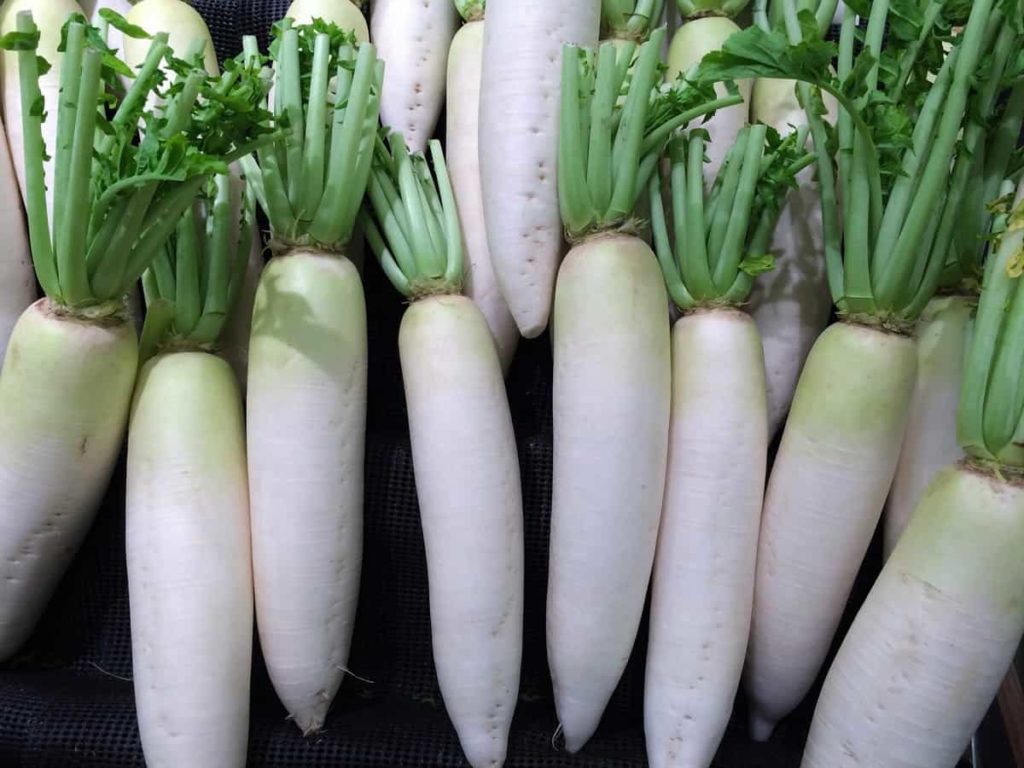
You can quickly solve these problems by amending soil, removing weeds, and rotating your crops. Making small changes like this is impressive and will leave you with healthy crops. Remember to make the soil work well, modify it as much as possible, and water regularly. Rotate your crops frequently, place them well, and place the water on the soil instead of leaves. These methods will help prevent most problems. You will be rewarded with an excellent crop to enjoy with just a little effort. Let’s check out common Radish plant problems below.
18 common Radish plant problems
Stunted or small roots
Radish grows best in loose, loamy, well-drained soil with aged manure and sand. The soil can compact if it is very clay-rich soil or does not contain enough aerating material. However, compact soil is less than ideal for bulb development. They will feel tight and will stop growing.
Solution – Make sure the soil’s pH is about 5.8 to 6.8, and add more aged manure to the soil before planting than you think you’ll need. In addition to the sand, you can work some perlite there for extra aeration. The aim is to make the soil work for the fluffy tilth, at least 12 inches deep. You should provide enough space for your roots to develop seamlessly.
Failure to germinate
These vegetable seeds are partly for growing from mild dependence. As a result, if you have planted them very deeply, you may face seed germination failure.
Solution – To sow, rake the soil surface and scatter the seeds around. Sprinkle water lightly. Do not soak too much otherwise, the seeds will float elsewhere. You will moisten the soil, not saturate it.
Cracked roots
It is caused by irregular water and is easy to prevent as far as Radish growing problems are concerned. Just make sure your Radish beds get constant water in the growing season. If you allow the soil to dry and then water deeply, the roots of Radish will pass faster in large-scale growth, more than their outer flesh and skins can handle. These cracks are like deep, dirty stretch marks and can leave roots open to various diseases, insect strains, and rots.
In case you missed it: Best Fertilizer for Radish: Homemade, Organic, NPK, Liquid, Natural, and Compost Manure
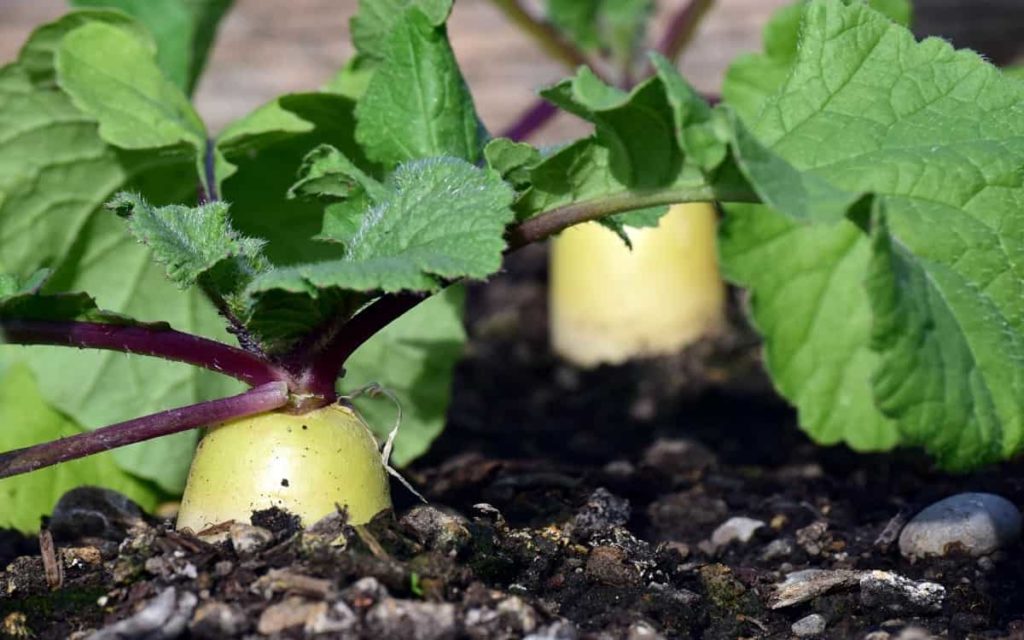
Solution – Aim for regular, gentle water instead of an irregular deep soak. You can use sprinklers on the timer so that it sorts that out for you daily.
Deformed roots
If your Radish looks thorny or strange, there is a lot of heavy grit in the soil. When the growing roots come into contact with something big, they won’t have the power to push it away. Instead, it will adapt to the formation around the barrier. It can result in twisted, thorny, or otherwise confused-looking roots.
Solution – To avoid this problem, make sure to rake and sift through anything larger than ¼ inch as you prepare your soil beds.
All leaves but no roots
Excess nitrogen in the soil will force your plants to grow leaves too much, but they won’t produce healthy roots or bulbs. You can fix this problem by checking soil nutrient levels before planting in spring. Then, modify with more carbon to balance nitrogen levels and modify with potassium and phosphorus.
Solution – If abundant leaf growth occurs in the mid-growing season and it is too late to modify soil for your existing plants. After all, Radish green is some of the most nutritious leaves you can eat. They are high in iron, calcium, vitamin C, and phosphorus and are full of antioxidants. Try them like Spinach, braised like a Kale, or steam lightly to maintain as many nutrients as possible.
Radish leaves are turning white
If you find out leaves turn white, it is most likely caused by mildew or sun scorch. Powdery mildew affects many different plants and crops, and this fungus can cause your Radish leaves to dry. It happens when your garden is crowded or perhaps your Radish has been affected by a lot of shade. Sun scorch is a direct result of the sun and can cause white or bleached-looking patterns on Radish leaves. Although the sunburns may not damage your Radish leaves, they can make them bend and weaken.
Solution – If your garden is crowded or your Radishes are given too much shade, the white color you see on your leaves can be mildew. Powdery mildew Solution is an organically sourced mildew treatment that will successfully remove white from your leaves. Coat all sides of the affected leaves entirely with this solution.
You will be able to see your leaves return to their healthy and natural state in less time. However, your Radish leaves may be turning white because they have been exposed to full sun. Thankfully you can prevent the sun from burning by using some sunshade to prevent white stains from forming on your leaves.
In case you missed it: Growing Radish In Greenhouse – A Full Planting Guide
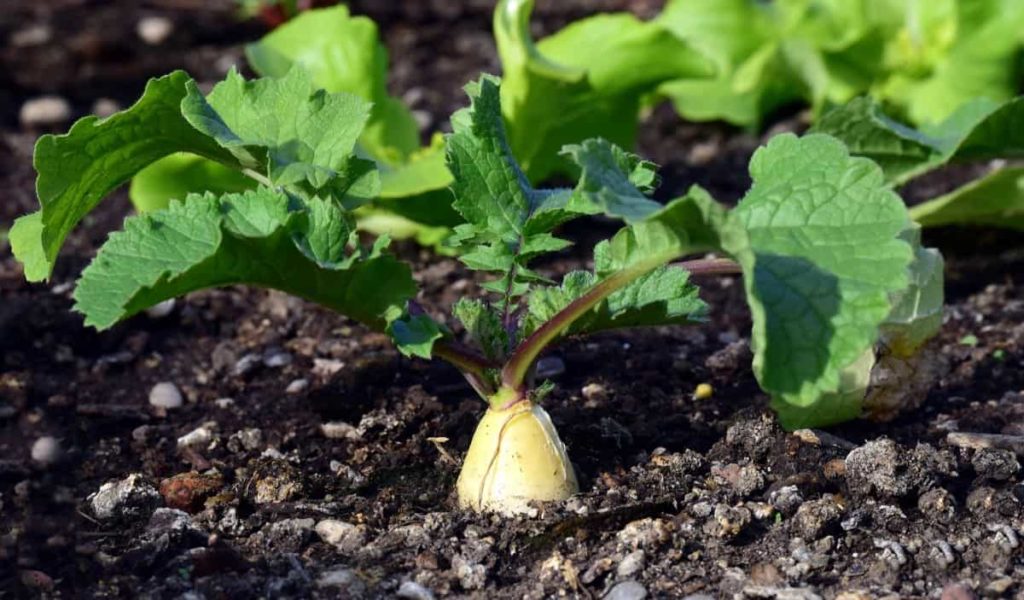
Flower formation
Radish needs several hours of sunshine every day, but they appreciate the partial shade during the hottest part of the day. Moreover, remember that Radish excels in cold weather. Therefore, they are very likely to bolt in the midsummer heat.
Solution – Aim to grow your Radish as early spring and mid-fall crops instead of the hottest part of the year. If you plant them with your Peas and Lettuce, you can get the best Radish crop. Since Radish needs a little shade to protect them in the afternoon, consider putting them behind your Peas and Bean trellis.
Radish leaves turning red
Sugar can begin building up if your soil lacks plenty of phosphorus, making leaves red. Inappropriate water methods can also cause red leaves. Giving your Radishes more water and keeping them underwater can’t give your Radish all the nutrients or oxygen it needs.
Solution –It’s easy to turn your red leaves back into green if you know what to do. If you suspect that your soil phosphorus levels are low, do not add anything to your garden until you test the soil. After successfully experiencing the soil, you will know the phosphorus level of your garden and what steps need to be taken to maintain balance in your garden. It is also essential to know how much water to give your Radish, as you do not want to do your crops with much water or underwater. Taking care of all these methods will keep your leaves their natural green color.
Radish leaves are turning black
Not only is inappropriate irrigation why your leaves are black, but it can cause bacterial or fungal infections at fault. The bacterial infection your Radish may come into contact with is most likely due to improper irrigation. When you apply more water to your crops, you take away their nutrients and oxygen supplies, which is when the infection can start. It’s the same with going underwater, and the fungus can also start forming when your Radish doesn’t get enough nutrients or adequate amounts of ventilation.
In case you missed it: Radish Seed Germination, Time, Temperature, Procedure
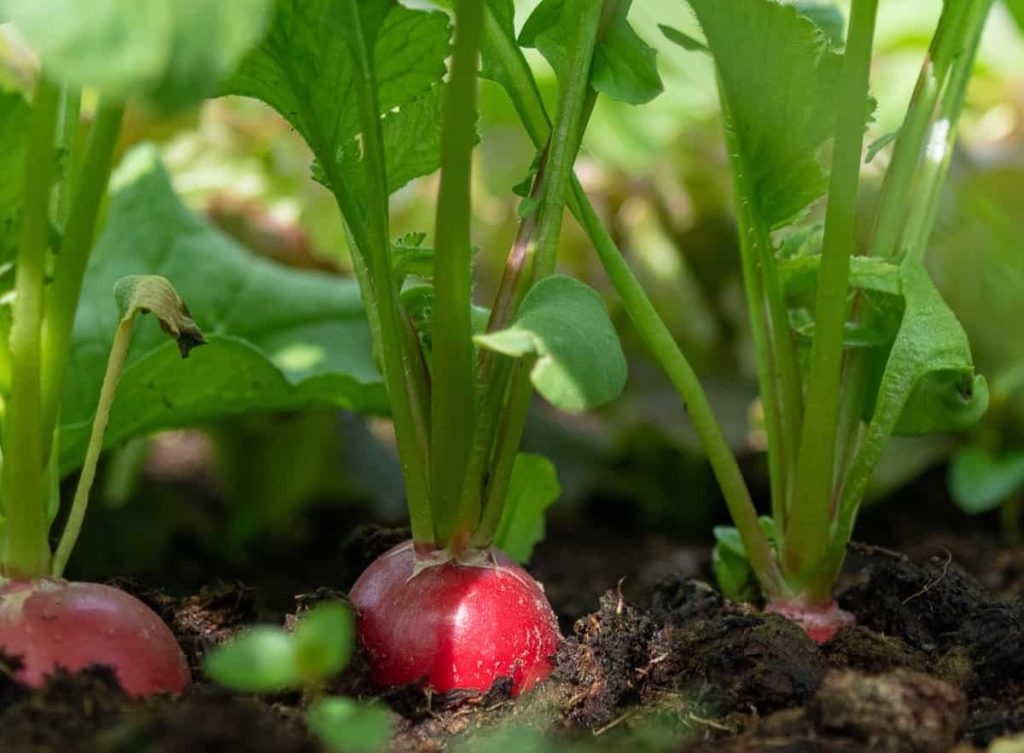
Solution – To prevent spots of black bacteria leaves, make sure you water your Radish correctly and keep it properly ventilated. In addition, to avoid the formation of fungus on your Radish, it is recommended to use organic fungicides solution to get rid of unwanted fungus built on your vegetables. Another way to avoid growing black leaves is to make sure you have not used too much soil.
Excessive fertilizer consumption can cause a significant build-up of salt, which can cause your leaves to be black. Just remember how much water you are using, along with the amount of fertilizer you are using when building the base of your crops.
Woody Radishes
Leaving Radish too long in the garden can also cause them to become stiff and wooded. Radishes need to grow faster to be soft and thick when harvested. If Radish doesn’t get the cool temperature and plenty of regular water they need, it will take longer for them to reach their mature size, and you may be willing to leave them in the soil until they are filled.
Solution – Spring and fall are the most accessible times to grow Radish. However, some Radishes, such as the ‘Black Spanish’ type, prefer to be grown in the short days of decline. Therefore, they are planted in winter and harvested in spring. Although the black Radish looks stiff, their skin is quite soft. Keep an eye on white flesh, though it’s spicy.
Pests
Aphids
Aphids are Radish’s most serious pest. They attack both seedlings and mature crops. Cloudy, humid weather conditions favor the spread of their attack. In the event of a heavy attack, the plants become completely deweighted, leaves and shoots are turned, yellowed and eventually die.
Solution – One liter of nicotine sulfate in 800 liters of water is also effective. Spraying Nuvacron 1.25 millimeters or Metasystox 2 millimeters per liter of water is also recommended.
Mustard saw-fly
Mustard saw-fly is a common pest of Radish and Turnip. In Radish, it appears when the crop is in flowers and at the vegetative stage. The damage group was done by biting holes in leaves and fruits.
Solution – Mustard saw-fly can be controlled by dusting 10% BHC at the rate of 15 to 20 kg per hectare by dusting 35 to 40 kg per hectare at the infected crop’s vegetative growth stage seed formation. In addition, a spray of 4 grams of sevin per liter of water at weekly intervals can also control the pest.
Flea beetle
In some areas, it becomes a severe pest on the vegetative parts of the plants consumed by this pest.
Solution – It can control it by spraying with malathion or sevin for 10 to 15 days.
In case you missed it: Growing Hydroponic Radish, Process, Requirements
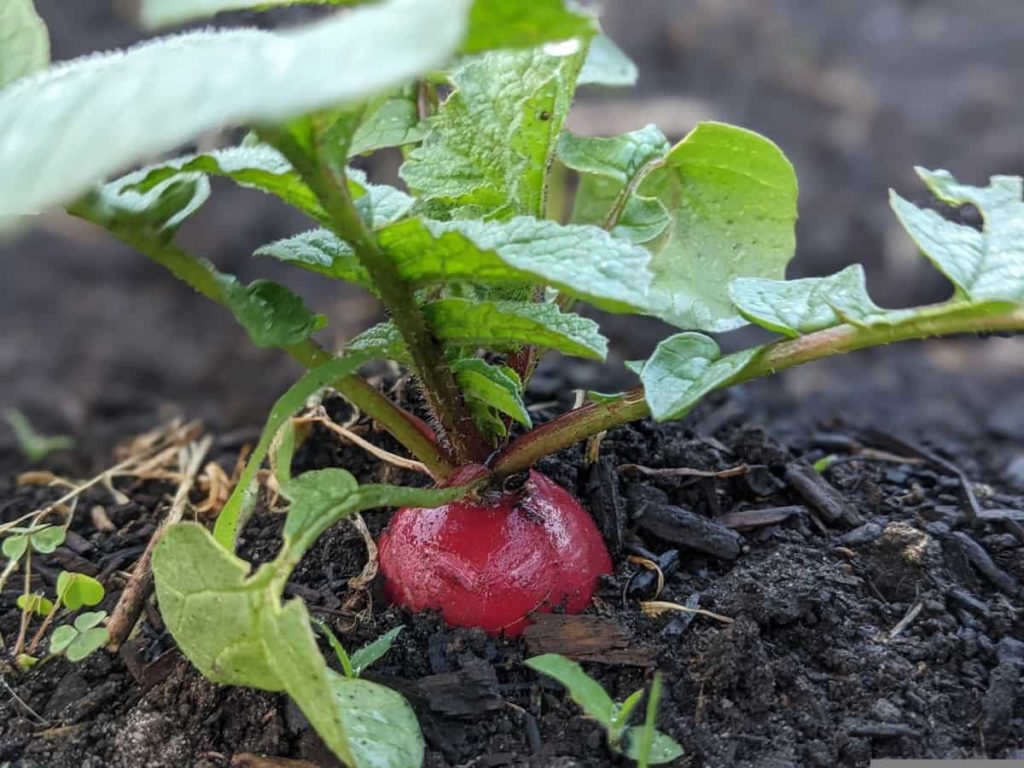
Diseases
Alternaria blight
Symptoms usually appear first in the form of yellow on leaves, spots a little raised, or lesions. The infection spreads rapidly during the rainy season. The fungus eventually enters pod tissues affecting seeds. Affected seeds can lose their ability.
Solution – The use of disease-free seeds is the primary requirement. If seeds are being produced or the vegetable crop is high, it is recommended to spray the crop with fungicides. Copper oxychloride, maneb or zineb, or blitox can be used as a spray.
White Rust
It produces a white powdery substance in patches at the lower level of leaves. It appears mainly on leaves and flowering shoots that get spoiled and only tolerate malformed flowers.
Solution – The destruction of diseased crop debris helps in reducing inoculum. Weed control and other cleaning precautions are also necessary. The Bordeaux mixture or Dithane Z- 78 fungicides can be sprayed to control the disease effectively.
Downy mildew
The disease is categorized by the appearance of purple-brown spots on the surface of leaves. These spots can remain small or large enough. Downy growth is usually visible at the surface of these lesions.
Solution – Crop rotation, clean seedbeds, weed destruction, and other cleaning measures are essential to prevent the spread of the disease. In addition, you can reduce the severity of the disease by spraying maneb 2 to 3 times at intervals of 10 days after notice of disease in the field.
Black rot
It affects almost all the cruciferous plants around the world. The youngest seedling can affect the plant during its growth until it matures. The cotyledons are affected on the margins that show blackening on young seedlings, and such cotyledons die. Later, leaf infection is through water pores on the margins. The affected tissues become yellow and have chlorosis. Brown or black color appears in the veins.
Solution – The pathogen lasts only one year in the field, so two years of crop rotation is enough to prevent soil-generated infections. Several antibiotics such as Agromycin, Streptocycline, etc. Available. One of the recommendations is to give hot water treatment for 30 minutes at 52°C. Applying 10 to 12 kg of stable bleaching powder per hectare is also helpful.
In case you missed it: Radish Harvesting; Radish Plant Care; Radish Facts

Radish mosaic virus
Symptoms first appear as minor, rounded, irregular chlorotic lesions adjacent to the veins. There is little or no distortion in the leaf, and the abnormal formation of the leaf is rarely there.
Solution – The disease can be effectively tested by controlling the aphids with pesticides and weed hosts by spraying weedicides.
- Flower Garden Designs and Layouts for Beginners
- Planting and Spacing Techniques in Papaya: A Beginner’s Guide
- Growing Gold: Essential Techniques for Planting Pineapples
- How to Make Kalanchoe Plant Bushy: Home Remedies and Solutions
- 11 Reasons Why Your Gardenia is Not Blooming: Home Remedies and Solutions
- Eco Elegance: The Guide to Designing a Drought-Tolerant Landscape
- Gardening on a Slope: Strategies for Hillside Landscaping
- Nourish and Flourish: Top Organic Mulches for Thriving House Plants
- Everything You Want to Know about Indian Mogra Flower: Discover Uses and Growing
- Green Thumb Success: Expert Tips for Cultivating Greenhouse Pumpkins All Year Round
- Maximize Growth & Flavor: The Ultimate Guide to Companion Planting in Herb Gardens
- How to Control Rhododendron Problems Naturally: Home Remedies and Organic Ways to Fix Them
- Natural Magic: The Remarkable Benefits of Cinnamon for Plants
- Best Steps to Revive Dying Tulip with Natural and Organic Treatment
- 10 Reasons Why Your Angel Trumpet is Not Blooming: Remedies and Treatment
- How to Fix Periwinkle Leaf and Flower-Related Problems: Natural Remedies and Solutions
- How to Fix Zinnias Leaf and Flower Problems: Discover Natural and Home Remedies
- Organic Steps to Induce Lemon Tree Flowers: A Comprehensive Guide
- Bloom Booster: Crafting the Perfect Homemade Bougainvillea Fertilizer
- Optimizing Growth: A Guide to Applying NPK Fertilizer for Potted Plants
- 10 Best Homemade Fertilizers for Rubber Plant: DIY Recipes and Application Method
- How to Boost Female Pumpkin Flowers: Effective Steps for More Flowers and High Yields
- Transform Your Indoor Garden: Top Benefits of Pink Salt for Houseplants
- 10 Best Homemade Fertilizers for Peacock Plants (Calathea): Easy DIY Guide
- Unlock Blooms: 9 Reasons Why Your Potted Chrysanthemum is Not Blooming
- 8 Reasons Why Your Potted Hibiscus is Not Blooming: Fix it with Simple Solutions
- Unlock Blooms: 9 Key Reasons Your Potted Frangipani Won’t Flower
- 10 Reasons Why Is My Ice Plant Not Blooming: Remedies and Treatment
- 10 Reasons Why My Potted Hydrangea Not Blooming: Treatment and Remedies
- 10 Reasons Why is My Wisteria Not Blooming: Remedies and Treatment
- 10 Reasons Why is My Goldfish Plant Not Blooming: Remedies and Treatment
- Maximize Your Space: Ultimate Guide to Balcony Gardening with Grow Bags
- 10 Reasons Why Your Iris is Not Blooming: Remedies and Treatment
- 10 Reasons Why Your Anthurium Plant is Not Blooming: Treatment and Remedies
- 10 Reasons Why Your Aquaponic Plants Are Not Flowering: Remedies and Treatment
- 10 Reasons Why Your Agapanthus is Not Flowering: Remedies and Treatment